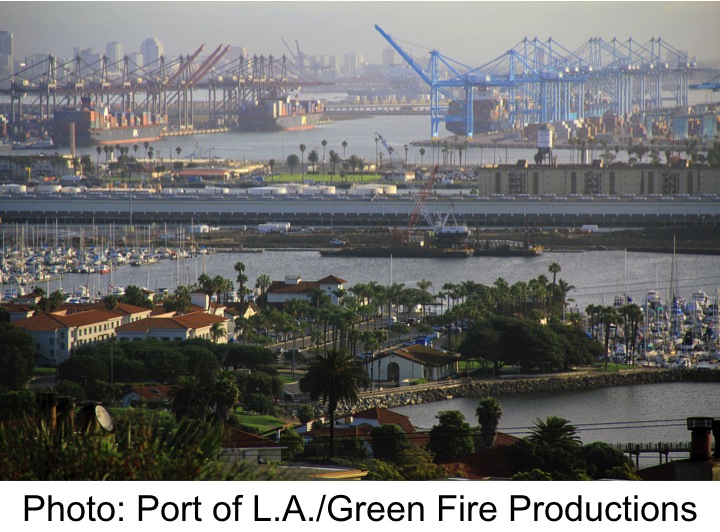Port of Los Angeles Secretly Broke Anti-Pollution Agreement
 Residents feel betrayed. Green groups are enraged. Politicians call for change.
Residents feel betrayed. Green groups are enraged. Politicians call for change.
What happened?
In 2003, an anti-pollution agreement was made–well, a settlement, really–in which the Port of Los Angeles was to follow several practices to reduce the harmful pollution generated at the port.
The port was doing a big expansion at the China Shipping Terminal. The expansion caused a huge outcry from the public, whose health was being overlooked, that led to a lawsuit against the port and city of Los Angeles.
A $60 million settlement was reached and approved by the state judge on the case. That settlement was received with excitement as it would allow the Port of Los Angeles to move forward with its expansion of the China Shipping Terminal and reduce pollution, benefiting the health of those in the communities near the port.
The New York Times published an article at the time with a quote that encapsulates the optimism created by the deal:
”This settlement will create a model terminal for what a green port should look like,” said Gail Ruderman Feurer, a lawyer with the Natural Resources Defense Council, one of the groups that sued the city and port for failing to assess the environmental impact of expansion there. ”Many things the city has agreed to do will be done for the first time in the City of Los Angeles.”
Or would it?
Barbara Whitaker summarized the settlement in the 2003 New York Times article:
Under the settlement in State Superior Court, a $50 million fund will be created to reduce the impact of port operations, which generate high levels of air pollution, on the adjacent Los Angeles neighborhoods of San Pedro and Wilmington. Of that amount, $10 million is to go to reduce emissions from independently owned diesel trucks that serve the port; $20 million to efforts to reduce air pollution over four years; and $20 million to create parks and clean up and beautify areas around the port.
In addition, $10 million was earmarked for specific changes at the China Shipping terminal, a major expansion at the port that led to the public outcry.
As part of the settlement, the city agreed to provide electric power to ships so they will not run their diesel engines, and $5 million will go to retrofitting vessels so they can use the electricity. Another $5 million will go toward replacing 16-story cranes with ones with a lower profile. The agreement also specified that cleaner alternative fuel trucks will be used at the terminal.
The settlement money will come entirely from port revenues.
It was this lawsuit settlement, and the environmental reviews it created, that forced the Port of Los Angeles to add 52 mitigation measures to an environmental impact report in order for approval to be granted for expansion of the China Shipping terminal in 2008.
It turns out, several of those 52 measures have quietly not been implemented by the Port of Los Angeles. The port finally admitted such in a document released in September:
Most of these measures have either been completed or will be completed within the time period for implementation. These completed or to be completed mitigation measures are outside of the scope of the proposed Project and will not be further considered in the Supplemental EIR.
There are 11 mitigation measures, however, that have not yet been fully implemented for various reasons.
Then a chart is provided in the document, recreated below, listing mitigation measures wished to be reviewed and changed. There are actually 12 measures listed in the chart.
|
Mitigation Measure |
Description |
|
AQ-9 |
Alternative Maritime Power (AMP) for 100% of vessels |
|
AQ-10 |
100% compliance with 40-nm Vessel Speed Reduction Program |
|
AQ-15 |
Liquefied petroleum gas (LPG) Yard Tractors/0.015 g/hp-hr PM |
|
AQ-16 |
Emissions standards for yard equipment at Berth 121-131 rail yard |
|
AQ-17 |
Emissions standards for yard equipment at Berths 97-109 terminal |
|
AQ-20 |
LNG-powered drayage trucks (70% through 2017, 100% in 2018 and thereafter) |
|
AQ-23 |
Throughput tracking to verify EIR assumptions |
|
NOI-2 |
Noise walls and soundproofing of noise-sensitive structures |
|
TRANS-2 |
Modify Alameda St/Anaheim St by 2015 |
|
TRANS-3 |
Modify John S Gibson Blvd/I-110 N/B ramps by 2015 |
|
TRANS-4 |
Modify Fries Ave/Harry Bridges Blvd by 2015 |
|
TRANS-6 |
Navy Way and Seaside Ave by 2030 |
The changes the port is hoping for in the review? The document clarifies:
Changes could include elimination of measures that have proven to be clearly infeasible, addition of replacement measures to address those impacts, and revision of measures that have proven problematic to implement in order to achieve comparable results.
So all these years the public has thought the Port of Los Angeles had implemented many pollution mitigating measures at the extremely large China Shipping terminal, measures that got expansion of the terminal approved, only to find out the port not only did not implement the measures, but is now seeking to have the measures eliminated or changed.
AllGov.com published an article that elaborates on how bad the port’s “shortfalls” on these pollution fighting measures has been:
Tony Barboza reported that China Shipping North America, which operates a giant 130-acre terminal near Vincent Thomas Bridge, received a waiver from the port that let it ignore an agreement requiring ships to plug into on-shore electrical outlets instead of belching out pollutants while their diesel-engines idle. The waiver was issued shortly after an environmental impact report was approved for the terminal expansion in 2008.
The Times used the California Public Records Act to obtain documents detailing the waiver in 2009, which let China Shipping off the hook for a rule that required at least 70% of ships to plug in and shut down. “The Port will not hold China Shipping responsible for any outcome as a result of not meeting the 70 percent AMP requirement,” then-port Executive Director Geraldine Knatz wrote in a letter.
The port issued other waivers after regulations further tightened in 2011 until state regulators put a stop to it last year, the Times said. But, by then, plugins had dropped from 66% in 2011 to 12% in 2012 and more diesel fumes were billowing into some of the nation’s worst air. Compliance hit 98% in 2014 after state regulators said they had to hook up.
Other shortcomings at China Shipping were recorded by port employees but not acted upon. Some trucks and yard tractors that should have been switched to alternative fuels were not and ships that were supposed to slow down as they approached did not.
The Times said records showed China Shipping converted just 6% of the vehicles, a tad short of the required 70%. Requests by the Times for records and reports that China Shipping was to make public on a regular basis―as a condition of being allowed to expand the terminal―came up empty.
Was that sarcasm at the end from the Times?
It’s no wonder people are so angry and “Rep. Janice Hahn (D-San Pedro) is throwing her support behind the demands of harbor-area residents calling for independent oversight of the Port of Los Angeles,” as reported by the L.A. Times.
Port of Los Angeles Executive Director Gene Seroka addressed the situation in a written, prepared statement in October, shortly after the communities around the port became aware of the ports actions (or non-actions) at the China Shipping terminal.
After pointing out emission inventories are “currently at or below all levels studied in the 2008 Environmental Impact Report,” Seroka went on to say:
Secondly, we are faced with an unfortunate issue of delayed implementation of mitigation measures. This is a situation that was inherited by this current Port management team. We are taking ownership. It must be addressed. The Board of Harbor Commissioners, along with the Mayor, and I are committed to fixing the issue. We are solution driven. And we are committed to ensuring that something like this never happens again.
Seroka goes on to talk about the economical benefits of the port, the jobs it supports, and so on. He also gives insight into how the port failed to implement many of the mitigation measures and why its leaders came to the decision to seek changes (including elimination in some cases) of measures that have not been enacted:
The Port implements its mitigation measures by including them in leases with its tenants. The Port engaged in an extensive negotiation process with China Shipping to amend its existing lease for the terminal to include these new mitigation measures but never entered into an amended permit incorporating the mitigation measures. Over the course of this lengthy negotiation process, it became apparent that there were technological, economic and operational challenges that suggest that some of the adopted mitigation measures are infeasible.
Based on this information, the Port is preparing a Supplemental EIR that identifies and analyzes the potential environmental impacts of possible changes in the mitigation measures, based on the feasibility of some of the mitigation measures, the availability of alternative technologies, and other factors. As described in the Notice of Preparation, these measures include the requirements for 100% of vessels to use Alternative Marine Power; 100% compliance with 40-nm vessel speed reduction program; LPG-fueled yard tractors; LNG-powered drayage trucks; and emissions standards for yard equipment.
Anger over the situation is completely understandable.
A reaction reported in the Los Angeles Times captures why people, especially those in the communities around the port, should be so upset:
“This whole time we’ve been led to believe that this is a much cleaner project than it has been,” said Mark Lopez, who heads East Yard Communities for Environmental Justice. He said the pollutants could bring “untold health consequences to the community.”
In fairness to the Port of Los Angeles, it has invested a large amount into mitigation measures, apparently completing or working on the implementation of 41 of the 52 measures. Here’s one last quote from Seroka’s statement to emphasize that point:
…the Port continues to monitor conditions at the terminal. Most of the mitigation measures have been completed or will be completed within the time period for implementation. Indeed, the Port has invested more than $80 million in community mitigation measures at China Shipping’s terminal.
However, the way this whole thing played out makes the words, quoted in the 2003 New York Times article, of Noel Park, president of the San Pedro Peninsula Homeowners Coalition at the time, sound ominous.
”We have to be pleased, they’ve never done anything for us before,” Mr. Park said. ”We’ve certainly got ourselves on their radar screen. How that plays out down the road, however, remains to be seen.”
Certainly, more transparency will be demanded of the port so more can be seen than was the case during the decade after the 2003 settlement.
![]()
Source: UC Blog




